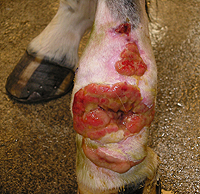Pathogenesis of aberrant wound healing in horses
Projektleder: DVM, PhD, diplomate i European College of Veterinary Surgeons, Professor Stine Jacobsen, e-mail: stj@sund.ku.dk

Non-healing wound on the hind limb of a pony. This wound has developed severe exuberant granulation tissue.
Accidental wounds in horses have a great propensity for poor healing. This is particularly true for wounds on the limbs of the horse, where a condition called exuberant granulation tissue may develop. This condition is characterized by excessive formation of scar tissue, which will slow down or completely stop healing of the wound. The reasons underlying this condition are incompletely understood, and without an understanding of the pathophysiology of the problem, rational treatment regimens cannot be developed. The slow and complication-prone healing thus poses an animal welfare issue and an economic burden to owners of horses that sustain wounds.
In this research theme the participants work to understand how chronic inflammation, poor blood and oxygen supply, and chronic infection in the wound bed may exert negative effects on wound healing in horses. Tissue biopsies are obtained for wounds with normal and aberrant healing and wound healing is histologically characterized. Global protein content as well as content of inflammation- and hypoxia-specific proteins is investigated by advanced proteomic methods (LC-MS/MS, QconCAT). Proteins that are differentially expressed in wounds with normal and aberrant healing may serve as potential therapeutic targets and give clues to the cause of the poor wound healing. Moreover, the group has implemented a method to perform minimally invasive, real-time sampling of proteins directly from the wound bed (microdialysis).
These studies have among other things demonstrated increased inflammation and increased hypoxia-driven enzyme activity in wounds with aberrant healing. Recently, a PhD project has been launched to investigate the presence of biofilm in wounds that develop exuberant granulation tissue. Bacteria organized in a biofilm – a short of protective matrix – are shielded from the host's immune system and from therapeutics such as antibiotics, and these chronic infections may inhibit wound healing and lead to formation of exuberant granulation tissue.
Perspectives of the research
This research theme is ongoing and will be expanded also to include studies aimed at improving healing of surgical wounds. Improvements in wound management will affect the numerous horses that sustain wounds every day. Delayed and defective healing have economic consequences for horse owners and these may be significantly reduced with improved wound care.
The project leader is professor of large animal surgery; this ensures that the research results are rapidly implemented in patient care. New treatments to combat chronic infections with biofilm-forming bacteria are currently under investigation.
Partners on the project
- Thomas Bjarnsholt, PhD, DrMedSci., Professor, Department of Immunology and Microbiology, University of Copenhagen
-
Lars Jelstrup Petersen, MD, PhD, Professor, Aalborg University Hospital
-
Elin Jørgensen, DVM, PhD student, Department of Large Animal Sciences, University of Copenhagen
-
Louise Bundgaard, DVM, PhD, Department of Large Animal Sciences, University of Copenhagen
-
Mette Aamand Sørensen, DVM, PhD, Novo Nordic
Financial support
PhD scholarship (Elin Jørgensen) from The Faculty of Health and Medical Sciences,
University of Copenhagen
Publications
Review abstracts from the 23 Conference of the European Wound Management Association, Copenhagen, Denmark, 2013
